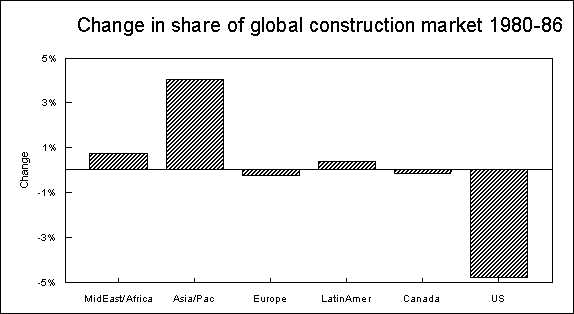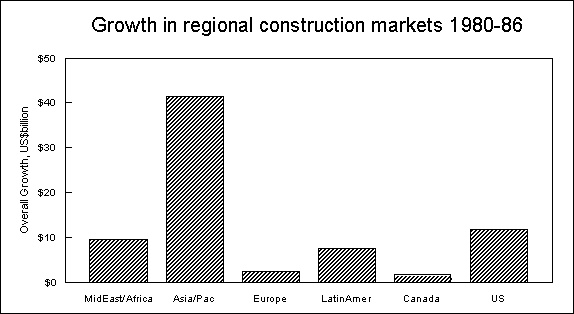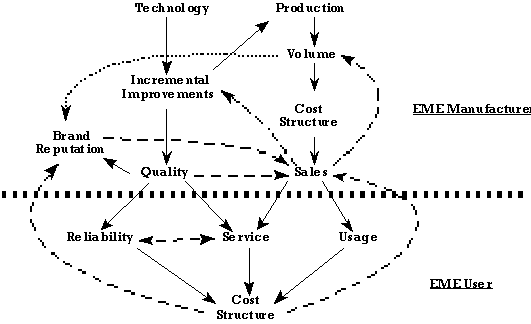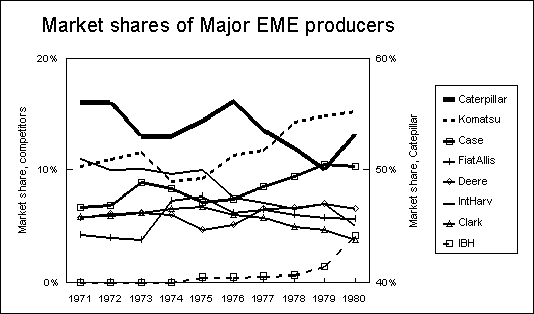
Caterpillar Tractor Co.[Case Assignment used a 1981 perspective] |
| Business Strategy - Case Assignment Melbourne Business School 6 March 1997 |
Author: Grant Gray Prepared for: Professor Geoff Lewis Word limit: 1500 |
Appendix A - Industry Porter Model
Appendix B - Growth in Construction Industry
Appendix C - Strengths of Competitors
Oil-rich nations have continued an ambitious construction programme. Nevertheless, concern is being expressed regarding the sustainability of the growth given its reliance on a single commodity and trends suggesting current soft demand for oil may move to a glut within the immediate years.
A second area of growth is within Asia-Pacific. This appears deeper than that of the oil-rich nations as it is not reliant on a single commodity. The Far East is experiencing a period of overall expansion while Australia is appears set to experience a boom in coal and mineral exports.
Latin America continues to see economic growth although this has slowed.
While growth is strong, many of the nations in these regions are facing capital limitations due to decreased aid from developed nations, a downturn in commodity prices and a looming debt crisis.
North America and Europe are in recession due in part to the oil shock and in part to the anti-inflationary stand of the US Federal Reserve. This has had significant impact on the construction industry. 1982 economic activity is forecast lower and the US dollar is forecast to strengthen.
Production methods, however, are undergoing radical change driven by manufacturing techniques pioneered within Japanese industry.
Several marketing and service developments are also underway. Time and cost constraints for EME users are forcing them to seek longer lives from their equipment and to improve performance using scheduled maintenance programmes. Reliability is critical. EME users are increasingly turning to rental arrangements to counter capital constraints and are increasingly asking for sales details that include several years replacement parts.
Of further note is the success of Asian based contractors in securing Middle East projects. Middle Eastern firms have increased their share significantly while US companies continue to perform badly with their share dropping from 30%+ in 1975 to 7% in 1980.
A Porter Analysis [Appendix A] reveals an industry characterised by

Prospects remain good - particularly in Asia/Pacific and in the Middle East. While growth
figures are low the net market increases in the US and Latin America amount to US$19
billion during 1980-86. The US market continues to fall as a proportion of the World
construction industry (from 50% to 45%) while Asia/Pacific will increase significantly (26%
to 31%). [Appendix B]
This suggests that EME manufacturers able to ride out the current US/European recessions, enable their customers to cope with increasing cost pressures and take advantage of Asian growth should find the industry attractive and profitable in the longer term.


Core to their strategy of success has been:
A number of salient approaches to this independence can be seen:
For the EME user this combination of production and technology has been realised as useable and reliable equipment with access to a solid service network through the dealers.
Brand reputation has been built firstly on the products themselves and secondly on the experience of the users. A tertiary support of this reputation has been the sheer number of Caterpillar products sold - users, construction and mining investors and mechanics are familiar and comfortable with Caterpillar EME.
This strategy has been and is successful. EME users most important criteria are:
Price and parts availability closely follow.
Caterpillar has aligned its own strategies to these criteria.

To date the approach to manufacturing of investing heavily in a few large production
facilities which supply non-US plants set-up to meet local content requirements or customise
has provided cost competitiveness. The strategy of high in-house production of parts (90%)
has given Caterpillar control of their manufacturing although whether such a high degree of
backward integration cost effective cannot be determined from the case.
Likewise the approach to marketing of using independent dealers has given Caterpillar access to local entrepreneurs who know their markets and their users.
Concern lies not in the current strategy and its contingent approaches but whether it will remain competitive into the future.
Of the competitors Komatsu appears of most concern and is steadily gaining ground. As the #2 EME manufacturer and holding a dominant 60% of their Japanese home market the company is already providing strong competition.
Komatsu leads is in several areas key to Caterpillar including manufacturing, pricing, relationships and technology. [Appendix C]
Other producers have potential to challenge Caterpillar in niche product/geographical markets.
The steady gnawing at Caterpillar's share suggests that this is occurring.

Caterpillar's approach to service may be tested. Caterpillar relies on spread and inventory to
ensure spares are available to minimise user downtime. It underpins their reputation.
Komatsu takes a different approach and relies not on availability but on reliability generated at the factory using advanced production techniques. This builds their reputation and allows for reduced costs through:
While Caterpillar is competitive internationally on the back of their dominant US position the movement of the market away from the US and the importance of large government controlled projects in Asia and the Middle East will assist Komatsu and its approach.
Coinciding as it does with the US downturn and the strengthening US dollar, Caterpillar will come under pressure to maintain volume sales. With volume core to Caterpillar's cost control this could lead to low profitability over the next few years. This will test the loyalty of Caterpillar dealers.
Compounding this, labour problems that disrupt the ongoing supply of spare parts will damage the reputation of Caterpillar and cause great difficulties for users of their equipment.
| Manufacturing | Japanese production systems are some 5 years ahead of Caterpillar. |
| Pricing | Komatsu is 10% to 15% cheaper. Morgan believes this reflects true values but 5% is due to access to cheaper Japanese steel and 10% is due to financial arrangements when selling. Neither therefore reflects value. |
| Relationships | Komatsu has cultivated direct relationships with Communist and Developing Nation governments. In the growth areas of Asia and the Middle East the major projects are controlled by government agencies and they can be expected to heavily influence any buying process. |
| Technology | Komatsu has arrangements with Cummins, International Harvester and Bucyrus-Erie and therefore has access to leading product design apart from their own considerable capabilities. |